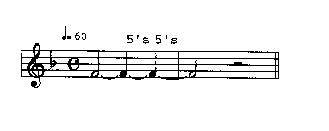
Vibrato Exercises
One of my other Trumpet Topics covered the subject of trumpet Vibrato. I would now like to share some exercises which I have used with students to work on vibrato. The studies can be used to help develop a vibrato by those who have not previously played with vibrato, and can also be used by players to gain greater control of their vibrato, or to help break old habits which have produced undesirable vibrato characteristics. I suggest incorporating these exercises at some point in the warm-up routine.
The first stage is to simply gain control of bending the pitch down and then back up. Play the following exercise 1 or 2 times daily for about a week. On a C scale, try to bend each pitch down a half-step by the lip (actually the combination of lip-jaw-tongue)

The second stage is to develop a control of the alternation between holding a steady tone, and that of bending the pitch in rhythm. Play the following exercise on each note, up and down, of a C scale and an F scale for about two weeks. The "dips" in the pitch should have a tempo of about 2 per second, and should bend down at least a quarter-step.

This won't sound like a vibrato yet - it is too slow and too wide. This exercise is simply designed to gain a feeling of the difference between holding a tone steady and moving the pitch in rhythm. Notice that it is written as a group of five dips. Five is the number of vibrations per second of our vibrato as applied to actual music.
The next stage is to gain a control of playing the vibrato at the proper speed of 5 vibrations per second. Apply the following exercise to each note of a scale during the daily warm-up routine. This exercise is similar to the one above; each of the quarter notes should receive five "dips". Continue to make the amplitude of the vibrato extremely wide so you can hear whether the rhythm is steady.

This exercise should be practiced daily for about 2 weeks before attempting to apply vibrato to musical examples. Even after the player starts to apply vibrato to music, I would suggest continuing to use this exercise daily as part of the warm-up to ensure solidifying rhythmic control.
The next stage is to apply these vibrato "5's" to specific pitches in actual musical examples. Pick lyrical examples with a mixture of whole, half and quarter notes. Apply a specific number of dips to the whole and half notes. Continue to make the amplitude extremely wide. This will still will not sound like a beautiful lyrical vibrato yet, it is just an exercise to gain rhythmic control. The player should practice this "applied vibrato" for a few weeks. After this point the musicianship of the player will generally take over and a lovely, controlled vibrato will begin to appear in their playing.
Back to Trumpet Topics Home Page
Back to Bryan Goff's Home Page
E-mail: bgoff@fsu.edu